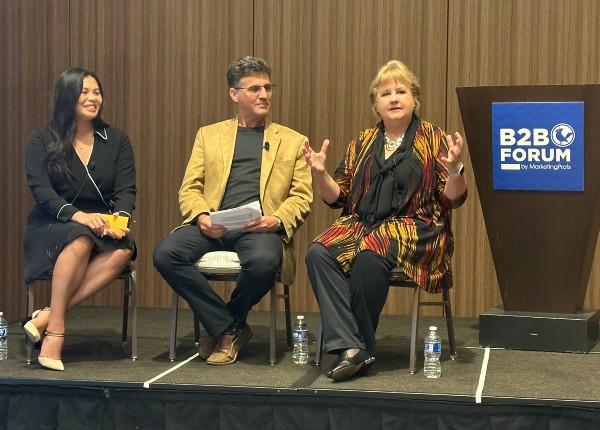A study from Search Engine Journal reports that 54% of B2B professionals engage with a webinar on a weekly basis. During the digital transformation of marketing and the shift to digital channels for communications since COVID, webinars have become a cornerstone for many B2B marketers.
Recently, I learned of a new study about webinars during the MarketingProfs B2B Forum that was commissioned by webinar software provider Hubilo and conducted by Forrester. This new study highlighted the challenges marketers face with webinars as well as their potential. At B2B Forum the two companies held a panel to discuss the research and share insights.
The panel included:
Erik Newton, CMO at Hubilo
Kathleen Abdeen, Director of Product and Field Marketing at Hubilo
Laura Ramos – Vice President, Principal Analyst at Forrester Research
It was great to see my longtime pal Laura Ramos from Forrester dive deep into the results of her research. Here’s an overview of what she and the marketing execs from Hubilo shared:

Hubilo executives with Laura Ramos from Forrester Research
Challenges and Statistics:
- Webinar Objectives: Marketers are leveraging webinars for brand awareness, lead generation, and as on-demand content.
- ROI Measurement: 64% of marketers face challenges measuring the ROI of their webinars. The struggle to quantify impact reveals an opportunity for more sophisticated tracking and analytics.
Evolving Role of Webinars:
- Historical Context: Laura mentioned that her initial research on digitizing events did not catch much attention, but the pandemic changed that perspective. The shift to digital made it essential to incorporate more interactive elements in webinars.
- Strategic Evolution: Initially, webinars were tools for retention and renewal. Now, their role has expanded, making them essential for mid-funnel activation, top-of-the-funnel acquisition, and community building. Laura and the panel stressed that the choice of the webinar host plays a crucial role in effectively reaching and building a community.
The Sales Cycle and Webinars:
With traditional B2B sales cycles spanning 6-9 months, webinars offer an opportunity to break the monotony. They can impact the top, middle, and bottom of the sales funnel, accelerating deal velocity.
To make a lasting impact, think of webinars themselves as campaigns. Create anticipation and a sense of ‘Fear of Missing Out’ (FOMO) around the live event. This not only boosts attendance but also promotes engagement.
Execution and Follow-Up:
- Before the Webinar: Utilize your email list, aiming for 400-500 attendees (or 200-300 for niche topics).
- During the Webinar: Focus on engagement. Use polls, chats, and offer incentives to keep attendees active and engaged.
- After the Webinar: Don’t let those leads grow cold. Remember, most of them are on-demand opportunities. Utilize data from the webinar to craft personalized follow-up messages and equip sales teams with valuable insights.
“Using webinars for post-sale engagement is an untapped opportunity. Webinar attendees are a sort of community and you can use the event to educate through Office Hours style format.” Laura Ramos, Vice President, Principal Analyst at Forrester Research
Technology and Insights:
Webinar platforms that offer actionable insights are invaluable. These insights can inform who the buyer is, enabling better engagement. Registration processes can capture intent signals, offering precious nuggets of information for more tailored follow-ups.
Reframing Your Webinar Strategy:
Laura suggested three ways to re-look at webinars
- Engagement: Webinars should not just be for prospects but also for existing customers. For instance, hosting “Office hours” webinars can be a platform for Q/A with experts.
- Always-On: Companies invest significantly in websites but often overlook the prolonged engagement webinars can offer – before, during, and after the event.
- Integration: Webinars should be a primary component in the marketing mix, akin to the main course in a 10-course meal. It’s crucial to ensure webinar data accuracy and integration with other marketing technology.
Best Practices and Final Thoughts:
- Collaborate with the sales department for a cohesive webinar go-to-market strategy.
- Use webinars to inform your nurture strategy, ensuring cross-functional teams are primed for success from the outset.
- Personalization is crucial – not just post-event but also before and during the webinar. As Laura emphasized, this ensures higher attendance and engagement.
In an age of do more with less and increasing expectations of marketing to prove out ROI, webinars have become an important tool for engaging prospective customers in a way that drives engagement and purchase intent. For that reason, I think webinars represent a substantial opportunity for B2B marketers to enhance the impact of their marketing mix. You can check out the research report on webinars from Forrester and Hubilo here.
For more insights on webinars for B2B marketers, check out these posts:
How B2B Marketers Can Get the Most Out of Webinars
Webinars That Wow: 5 Tips for Create Engaging Webinars
Content Marketing Tactics: Webinar Pros, Cons, Examples & Best Practices
If you’d like to optimize your webinar effectiveness by partnering with top experts in your industry, check out our influencer marketing solutions or connect with our team now.



